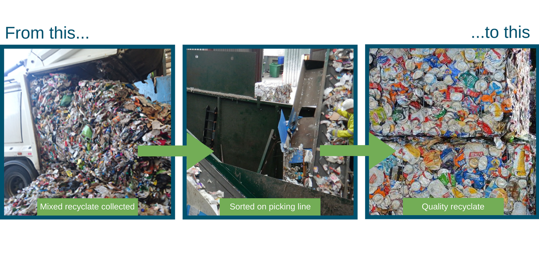Many people don't give much thought to what happens to their waste once their bins have been collected. So they don't realise that the separately collected recyclable materials are put through a series of sorting processes, using a mix of machinery and hand separation (that's real people working at nearby facilities to sorting through your waste). We asked Naomi Ross, from the Scottish Environment Protection Agency (SEPA)'s Waste Unit, to explain more about what's involved, the cycle of our waste and how we can help improve the quality of recycled materials.
Naomi Ross, Waste Unit, Scottish Environment Protection Agency (SEPA)
October 26, 2017
There is a widespread saying in the waste industry: "Rubbish in equals rubbish out". In other words, if recyclables are contaminated with non-recyclable waste during the collection process, such as food or nappies, it will be much harder for recycling facilities to produce top quality material to be used in manufacturing.
Most of the world's manufacturing takes place in China. Goods are then shipped to consumers in the UK and other developed nations where they are used, discarded and the recyclable elements sent back to China to be remade into new goods. These are in turn shipped back to the UK and other nations, and so the cycle continues.
If we want to maximise recycling of our waste in Scotland, instead of consigning it to landfill or energy-from-waste facilities, we need manufacturing industries across the world to buy our recyclable material. They will only do that if they are confident that the quality is good enough to replace virgin materials.

This is why the Scottish Government introduced the Materials Recovery Code. This requires recycling facilities to sample waste as it comes into and leaves the site, then report this information to the Scottish Environment Protections Agency (SEPA). The information, published quarterly on Scotland's environment web, gives buyers of recyclable materials from these sites a clear indication of the quality of their product. And, because SEPA verifies the data by conducting it's own sampling of the facilities' outputs, buyers can have confidence in the results published.
In July, SEPA published a report on the first year's findings of their sampling audits. Publishing this data helps improve transparency within the waste industry, providing valuable information about how Scotland's recyclables are managed - a key objective of the recently published waste data strategy (A strategy for improving waste data in Scotland).
A key message in the report is that, although the onus is on the recycling facility to sample and report, we all have a responsibility to help produce high quality recyclable material. Local councils can advise on which items should be put into which bins. Some will provide additional uplifts or different sized bins so there is enough capacity for the different waste streams. Cleaning our recyclable containers before disposing of them also reduces cross contamination of other items. More information on recycling and how you can get involved is available at www.recycleforscotland.com
You can find out more about the Materials Recovery Code and SEPA's work in this area, in the case study: Materials Recovery Code: Recyclate Quality on the Waste data strategy page of the Scotland's environment website.
Adobe Acrobat Reader is the free, trusted leader for reliably viewing, annotating and signing PDFs.
Download Adobe Acrobat Reader

